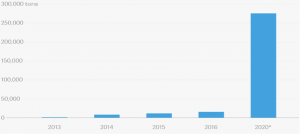In 2016, China became the world’s largest electric vehicle market accounting for over 40 percent of the electric vehicles sold worldwide. China passed the United States which had the highest electric vehicle sales in 2015. In 2016, China had over 1 million electric vehicles, which was an 87 percent increase over the previous year. They added 336,000 new electric car registrations; this included battery only and hybrid models. Electric vehicles range in price from $6,000 to $200,000 (for the most expensive Tesla model).[i] Like several European countries, China is planning to ban the sale of gasoline and diesel vehicles in favor of electric vehicles at an unannounced date.
China’s success in promoting electric vehicles is due to lucrative subsidies—thousands of dollars worth of subsidies—provided to buyers of these vehicles. For example, in Shanghai, a license plate costs about $15,000 if one is lucky enough to win the right to it in the lottery. However, if you choose to buy a plug-in hybrid, Shanghai will provide the license plate without cost.
China has decided to switch from subsidizing buyers to enforcing a quota system on manufacturers. Under the proposed quotas, most local and foreign automakers must earn points equivalent to 10 percent of vehicles they produce in China and import into the country in 2019 and 12 percent in 2020. By 2025, 20 percent of new car sales must be New Energy Vehicles.[ii] The plan applies to carmakers that produce or import 30,000 cars or more annually.[iii] Automakers that fail to meet the target will have to purchase credits from competitors that have a surplus.[iv]
The government has also subsidized charging stations for electric vehicles. As of December 2016, China had 300,000 charging stations. The country has ordered state-owned Chinese power companies to speed up installation of charging stations.
Electric cars make sense in China because of its dense and crowded cities that often mean shorter driving distances. China has an extensive high-speed rail system that reduces the need for long-distance road trips. In 2016, China had the largest electric car stock in the world with about a third of the global total. China is also the global leader in the electrification of other transport modes with over 200 million electric two-wheelers, 3 to 4 million low-speed electric vehicles and over 300 thousand electric buses.[v]
Battery Recycling and Disposal
But despite all the pros for electric vehicles in China, the country has a big problem with battery disposal. Electric car batteries are toxic if not disposed of properly and China does not have an official policy regarding their disposal. The problem will begin to escalate next year, and by 2020 China is expected to have almost 250,000 metric tons (276,000 tons) of batteries that need disposal—nearly 20 times those in 2016.[vi] (See graph below.)
The average lifespan of a lithium-iron phosphate battery, which is the primary type used in China’s electric vehicles, is around five years. Most batteries installed on electric vehicles during the 2012 to 2014 period will be retired around 2018.
Unusable electric vehicle batteries in China
* Forecast
Batteries can be recycled, but recycling them is not easy due to the sophisticated chemical procedures involved. If not handled properly, the heavy metal contained in the battery can lead to contamination of the soil and water.
In China, car manufacturers are responsible for recycling their batteries, but many of them expect battery suppliers to handle the recycling. China’s battery recycling industry is relatively small and scattered, and recycling operating costs are high. Even in the European Union, only 5 percent of lithium-ion batteries, another common type of battery power used in electric vehicles, are recycled.
Conclusion
China is now the largest market for electric vehicles and it is growing due to lucrative subsidies and a future quota system. Its dense and crowded cities are conducive to the use of electric vehicles. However, China will soon be confronted with another environmental problem in the disposal and recycling of batteries.
[i] Parallels, China Moves To Increase Number Of Electric Vehicles On Its Roads, April 25, 2017, http://www.npr.org/sections/parallels/2017/04/25/525412342/china-moves-to-increase-number-of-electric-vehicles-on-its-roads
[ii] Seeking Alpha, China To Ban All Petrol And Diesel Cars? Seriously?, September 12, 2017, https://seekingalpha.com/article/4106266-china-ban-petrol-diesel-cars-seriously?auth_param=1cqlaa:1crgicp:88f670313bfce71bb4d0f3f9532dae50&dr=1
[iii] Wall Street Journal, China Sends a Jolt Through Auto Industry With Plans for Electric Future, September 28, 2017, https://www.wsj.com/articles/china-sets-new-deadline-for-electric-car-production-1506608295?mg=prod/accounts-wsj&mg=prod/accounts-wsj
[iv] Independent, China to ban petrol and diesel cars, state media reports, September 10, 2017, http://www.independent.co.uk/news/world/asia/china-petrol-diesel-car-ban-gasoline-production-sales-electric-cabinet-official-state-media-a7938726.html
[v] International Energy Agency, Global EV Outlook 2017, https://www.iea.org/publications/freepublications/publication/GlobalEVOutlook2017.pdf
[vi] Quartz, China’s booming electric vehicle market is about to run into a mountain of battery waste, September 28, 2017, https://qz.com/1088195/chinas-booming-electric-vehicle-market-is-about-to-run-into-a-mountain-of-battery-waste/




